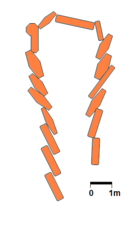Anta da Vidigueira
The Anta da Vidigueira is located southwest of the village of Freixo, near Redondo in the Évora district in Portugal .
The little Anta was probably built between the Neolithic and the Chalcolithic (between 4000 and 3000 BC) and has been classified as a Monumento Nacional since 1910.
The dolmen is one of the megaliths in the Évora district and consists of a polygonal chamber made up of seven columns in situ and the somewhat damaged capstone. The long-chambered Anta has a diameter of about 3.0 m and a preserved passage area of about 4.0 m in length, consisting of four stones on the right and one on the left. Remnants of the tumulus , which had a diameter of about 8.0 m, can be seen.
The finds include ceramics, blades and arrowheads .
The Anta da Candieira and other megalithic sites are nearby.
literature
- German Archaeological Institute - Madrid Department: Problems of megalithic grave research. Lectures on the 100th birthday of Vera Leisner . New York: de Gruyter Berlin et al. 1990, ISBN 3-11-011966-8 ( Madrid research 16).
- Thomas G. Schattner (Ed.): Archaeological guide through Portugal (= cultural history of the ancient world . Vol. 74). Philipp von Zabern, Mainz 1998, ISBN 3-8053-2313-1 .
- W. Vortisch: Geological-petrographic studies on megalithic monuments - examples from Portugal. In: Karl W. Beinhauer (Ed.): Studies on megalithics . = The megalithic phenomenon. State of research and ethnoarchaeological perspectives. Beier & Beran, Mannheim et al. 1999, ISBN 3-930036-36-3 , ( contributions to the prehistory and early history of Central Europe . 21).
- Jürgen E. Walkowitz: The megalithic syndrome. European cult sites of the Stone Age (= contributions to the prehistory and early history of Central Europe. Vol. 36). Beier & Beran, Langenweißbach 2003, ISBN 3-930036-70-3 .
Individual evidence
- ↑ Anta is the Portuguese name for around 5000 megalithic systems that were built during the Neolithic in the west of the Iberian Peninsula by the successors of the cardial or imprint culture .
Web links
Coordinates: 38 ° 40 ′ 35.1 ″ N , 7 ° 39 ′ 34.4 ″ W.

